Sculptures and 3D Art
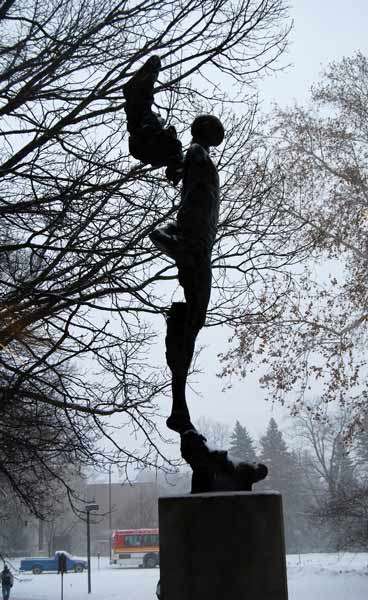
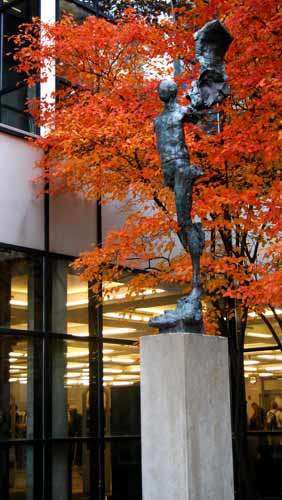
The Left-sided Angel greets visitors beside the south entrance to the Parks Library. Designed by Stephen DeStaebler in 1986, the 465-pound cast bronze sculpture stands eight feet high on a six foot pedestal. DeStaebler, a Midwest-born artist living in Berkeley, California, created the figure with limbs missing from its right side to symbolize the fragility of the human condition. Indeed, a consistent theme of the artist's work is the precariousness of people's place on earth. According to the artist, "Everyone when they were a kid, stood on one leg. It takes a lot of balance. And the idea of balance with this piece is very important, because it contributes to a sense of precariousness. The ability of the angel to remain upright affirms the ability of mankind to stay in balance." The angel was commissioned as part of Iowa's Art in State Buildings Program, with additional funding from Phi Kappa Phi Honor Society.
About the Artist
Stephen DeStaebler was born in St. Louis, Missouri in 1933. He received his A.B. from Princeton University in 1954, and his M.A. from the University of California at Berkeley in 1961. Since the angel was erected in front of the Library, it has elicited more than its fair share of reactions, just as one of the jurors who helped select the commission predicted: "... this university is going to grow as a result of this experience; a little cognitive dissonance is good for everyone." The juror was Dr. B.J. Nierengarten-Smith, director, Laumeier Sculpture Garden, St. Louis, Missouri. As the artist responds: "I get the best reactions to my work from people who aren't artistic and react from the gut. From my point of view, a piece is working when it provokes reaction, whether positive or negative. What's not so great is when people don't react at all. That means there's no emotional punch."
Shoulders of Giants
Iowa sculptor Nina de Creeft Ward was commissioned collaboratively by the University Library and the University Museums to create Shoulders of Giants, a low-fired clay sculpture with an oxide and light glaze surface. The sculpture was installed in the atrium of Parks Library in 1998.
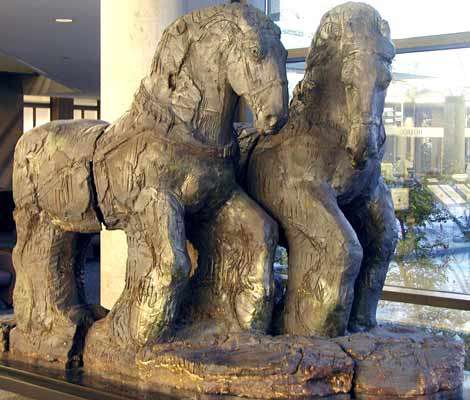
Inspired by the horses depicted in the Grant Wood designed mural, When Tillage Begins, the sculpture characterizes a teaching and learning situation. The theme of mentoring is demonstrated by a team of Percheron draft horses. The older, experienced horse is teaching the younger horse to work in harness.
The title of the work of art is derived from a quotation of Sir Isaac Newton in 1675/6: "If I have seen further it is by standing on the shoulders of giants."
About the Artist
"I consider myself a sculptor, not tied to any particular medium, but always involved in form, and changes of form. I am interested in surfaces, in color and pattern. Animals are the focus of my art. I am absorbed in their minds and bodies, feelings, habits, and concerns."
Nina de Creeft Ward
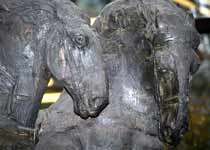
Born in New York City, Nina de Creeft Ward grew up in Santa Barbara and Ojai, California. She moved to Iowa in 1975 to reside in Cedar Falls, where she taught art at the University of Northern Iowa for nine years. Her father was the New York sculptor Jose de Creeft, and her mother, Santa Barbara sculptor Alice de Creeft, did bronze sculpture portrait commissions of horses and dogs for a number of years.
Nina Ward has loved animals from an early date, since her mother kept goats and a variety of other animals and her brother had a succession of riding horses. She was twelve when she bought her first horse, Red, out of a field in Goleta for twenty dollars. This horse predisposed her to favor draft horses, which she sketched at the Los Angeles County Fair in Pomona, California in her twenties when she was attending Scripps College. Once in Iowa, she drew horses at the Cattle Congress in Waterloo, the Britt Horse Fair, and at the Iowa State Fair. Study drawings done in Illinois serve as reference material for both her printmaking and sculpture.
Ward has a 1956 B.A. degree from Scripps College, a 1964 M.F.A. degree from the Claremont Graduate School, and has done additional study at the Massachusetts College of Art. Solo exhibitions have been shown in the Philippines, California, Maryland, Iowa, Chicago, and Kansas City. She is now a full-time artist and carves wood and stone, works in wax for bronzes, and does soft sculpture, etchings, woodcuts, and monoprints. Her clay animals include a variety of different animals which are sold in a number of galleries and shops throughout the United States.
Christian Petersen Sculptures
Old Woman in Prayer
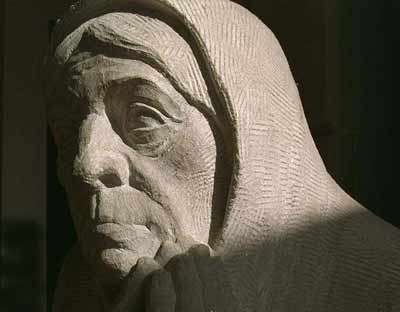
Christian Petersen had great compassion for the innocent victims of wars, the weak and the handicapped. In 1943 his deep emotions concerning World War II found outlet in the carving of Old Woman in Prayer (also known as The Refugee). The aged woman has her hands in prayer and eyes cast upward in a dazed search for refuge from terror. This studio sculpture is the artist's tribute to civilian refugees and concentration camp victims. Petersen's wife Charlotte regarded this piece as one of her husband's most eloquent works. She notes, "Christian was deeply moved by the barbarism and suffering of civilians during Hitler's Blitzkrieg. The sculpture tells that." The library acquired this work for the new building addition by purchase in 1983.
Boy and Girl
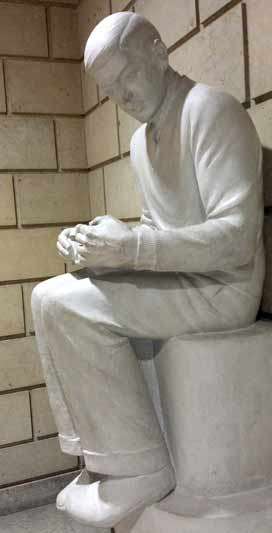
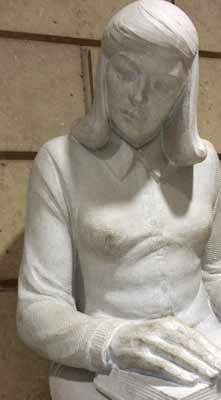
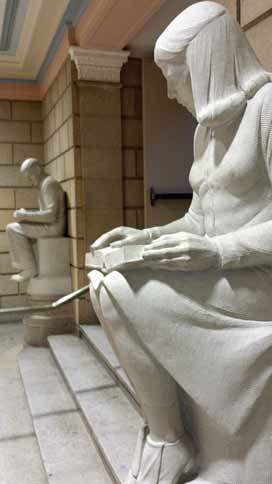
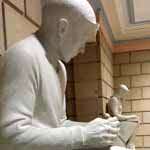
The idea for these figures first came to Christian Petersen around 1942 while he was looking at the bare pedestals which had been gathering dust in the library's lower lobby since 1925. Unsightly electric wires protruded from the bases which the architects had designed for light fixtures that were never installed. Petersen outlined his idea for stone figures to then president Charles E. Friley who gave him permission to proceed with the work in 1943. The result the next year was a pair of students, male and female, ostensibly studying with books in their laps, but fully aware of each other as they exchange glances across the landing of the stairwell. Petersen's humor may be seen in the fidgeting foot of the male student.
About the sculptor
A Danish-born sculptor, Christian Petersen (1885-1961) emigrated to America at the age of nine. After studying at the Technical School of Art in Newark, N.J., he enjoyed considerable success as a steel engraver and medalist while still a teenager. He studied sculpturing at the Rhode Island School of Design and at the Art Students League in New York. From there he went to Boston to study under Henry Hudson Kitson. In 1934 he was hired by Grant Wood to work with the Public Works of Art Project, and was assigned to work on the Dairy Industry Courtyard sculpture project which Iowa State University President Raymond M. Hughes had arranged with the WPA. Following a brief period in Iowa City, Petersen arrived at Iowa State University to become the first sculptor-in-residence at a U.S. university. He was appointed to the faculty in 1937, teaching and sculpting until 1955 in space converted to a studio in the old Veterinary Quadrangle.
The Library has two works in Bedford limestone by Petersen: the pair of students at the foot of the first floor stairwell in the original building, and the "Old Woman in Prayer" at the southeast corner of the glass curtain wall of the 1983 addition.
Many examples of Petersen's work are to be found throughout campus. The most well-known is probably the Four Seasons fountain with its Native American maidens on the north lawn of the Memorial Union. Other familiar works include the bas reliefs in the Dairy Industry Building, the Wedding Ring grouping around the pool on the south lawn of MacKay Hall, and the three terra cotta panels of athletes adorning the State Gymnasium. The sculpture of the Gentle Doctor tenderly holding an injured pup has been reproduced widely in veterinary publications, and has become a symbol of compassion for animals for the veterinary profession nationally.
Fireplace and Fireplace Tiles
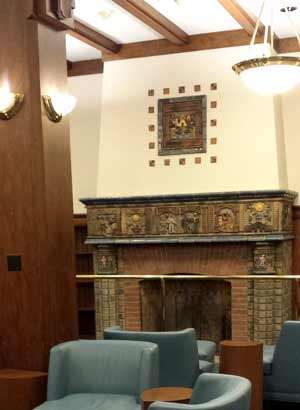
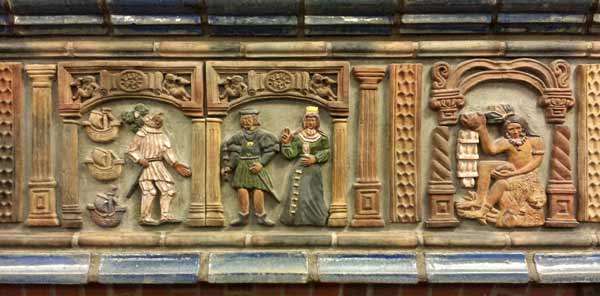
Location: The decorative ceramic tiles are located on the first floor in the Fireplace Reading Room near the entrance to Bookends Cafe.
Fireplace Tiles
A seldom-seen feature of the original Library is the fireplace which dominates the north wall of 191 Library. Decorative ceramic tiles designed by Henry Chapman Mercer adorn the chimney breast and mantel frieze. Subjects were selected from his series "Tiles of the New World" to depict the theme of "reaching out into the unknown." The Moravian Pottery and Tile Works of Doylestown, Pennsylvania executed the work for the new Library building in 1925. Titles of the individual fireplace tiles are shown below.
El Dorado
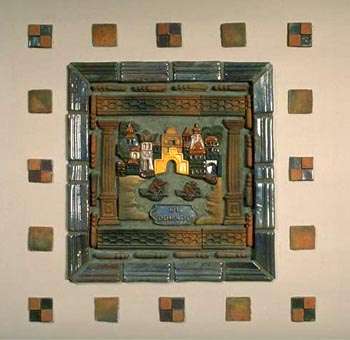
The fabled city of gold and riches sought by early Spanish explorers of South America. (Tiles of the New World no. 8)
Avalon
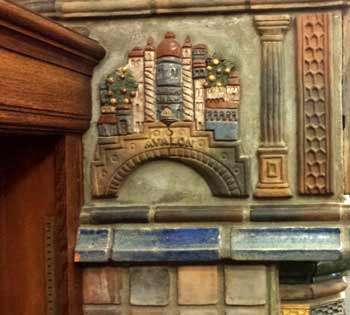
The island paradise of Celtic mythology. The fairy Morgana lived here where King Arthur's sword was supposedly forged, hence the name "Morgana" on the central tower. (Tiles of the New World no. 19)
Landing of Columbus
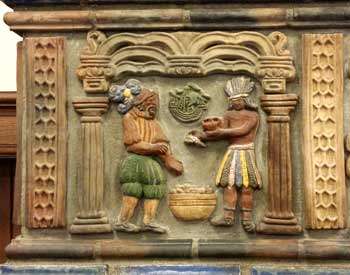
A Native American in feather headdress and girdle exchanges gifts with Columbus. On the ground between them rests a large basket of fruit from the New World. The design is after an old engraving. (Tiles of the New World no. 7)
Plus Ultra
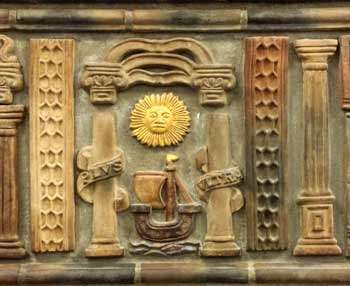
A ship sails between columns denoting the Pillars of Hercules at the east end of the Strait of Gibraltar, the gateway to the unknown. The motto, on banners coiled around the pillars, translates as "More Beyond." (Tiles of the New World no. 4)
Departure of Columbus
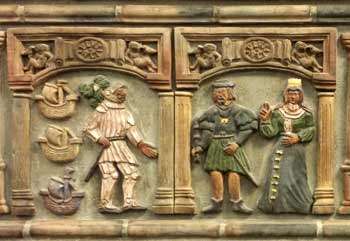
The explorer is depicted in armor and plumed helmet beside his three ships in the left arch of this double-wide tile. At the right, King Ferdinand and Queen Isabella of Spain give their blessing to the voyage. Putti recline in the spandrels above the figures with the abbreviated motto "Plus Ultra." Mercer's source for this design was a 16th century engraving by Theodore De Bry. (Tiles of the New World no. 3)
Making Arrowheads
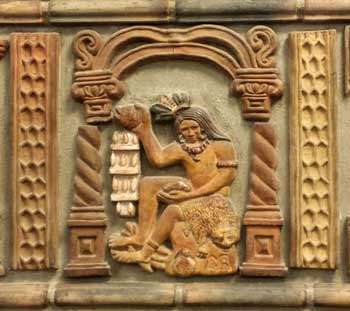
An original design by Mercer of a Native North American tool maker. A beaver skin rests on the artisan's lap as he chips away at a stone. A stack of finished arrow points may be seen to the left. (Tiles of the New World no. 41)
Worshipping the Sun
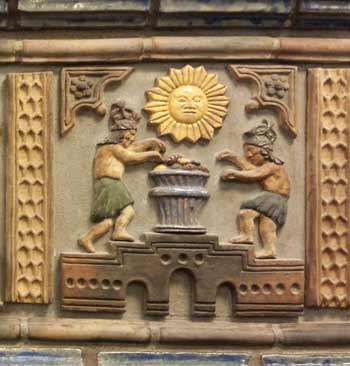
Native Meso-American priests stand on the steps of an outdoor temple offering a sacrifice of fruit as they worship the sun. The source for this design was an old engraving. (Tiles of the New World no. 14)
Fountain of Youth
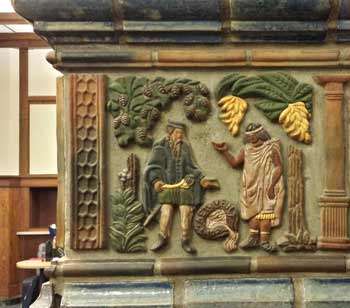
An elderly Spaniard is offered a cup of the fabled youth-restorative water by a Native American. The scene is framed by a lush banana plant on the right and a bountiful fruit tree on the left. The Latin inscription winding around the flowing water reads: "Aet juvent fons." (Tiles of the New World no. 10)
Historical Figures: 1
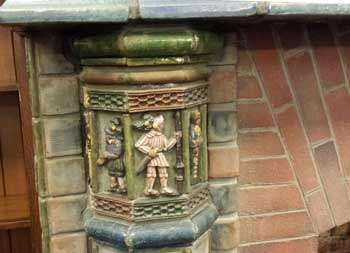
Historical figures, including those of Columbus and Queen Isabella, decorate the capitals of the engaged octagonal columns on either side of the fireplace.
Historical Figures: 2
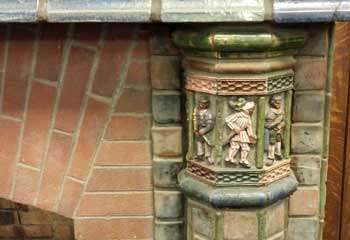
Norumbega
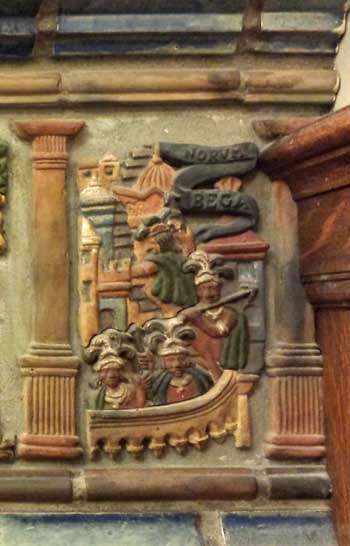
The name applied by 16th & 17th century map makers to an undefined region along the eastern coast of North America north of Florida. Native Americans wearing elaborate plumed headdresses and robes are set against buildings of exotic architecture. (Tiles of the New World no. 43)
About the Artist
Henry Chapman Mercer (1856-1930), an important figure in the American Arts and Crafts Movement, was founder, owner, and principal artist of the Moravian Pottery and Tile Works. He rebelled against the mass-produced tiles common at the turn of the century, and in 1899 began commercial production of tiles with a distinctively handmade look from native Pennsylvania clay formed by a hand press. Around 1908 he introduced a new style of tiles called "brocade" characterized by silhouettes modeled in high relief as opposed to the customary flat mosaic tiles. These new brocade tiles were used to produce an extensive series entitled "Tiles of the New World." Manuscript notes by Mercer included in Cleota Reed's book (cited at the end of this document) reveal the artist's thinking behind the series: "Unlike prints or paintings from nature, the clay patterns are conventionalized pictures, not intended to be correctly drawn, or to show perspective, distance or the scale of size or natural objects, but like the ornamental carvings of the old Cathedrals, to decorate the room by balancing each other as units of one continuous frieze or border, while telling a story in their own way."
In 1913 Mercer marketed the first twenty-nine of the eventual seventy-five scene "New World" series. They were produced as modular pieces in standard heights of 8 or 14 inches, and depicted scenes of early exploration of the New World from Leif Ericsson through Columbus and his successors, as well as scenes of Aztec and Mayan life. The "New World" tiles were the most popular of the relief series produced by Mercer, with the "Departure of Columbus" being the design in greatest demand.
It is from the "New World" series that Iowa State College librarian Charles Harvey Brown, in 1924, selected nine subjects to decorate the fireplace in the new Faculty Reading Room. In a letter to Mercer, the library director stated that he wanted designs that "incorporated fact with fancy to denote a reaching out into the unknown, i.e., the seeking for new knowledge through research." See photos and information about individual fireplace tiles.
134 Parks Library Doors
The doorways for the Learning Connections Classroom (134 Parks Library) are graced by three-dimensional artwork from Sticks, a Des Moines-based art company.
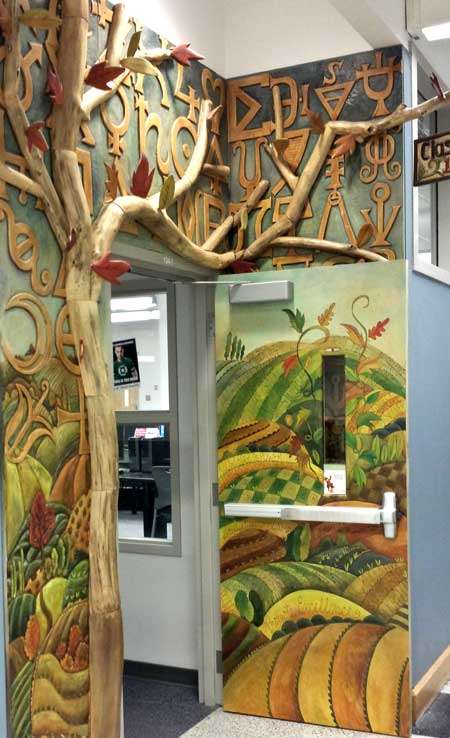
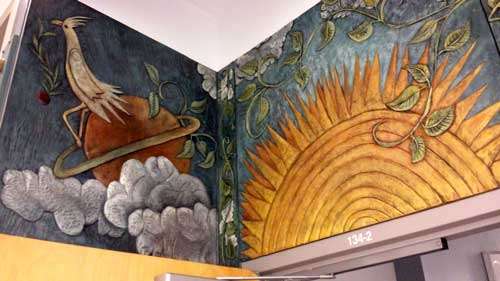
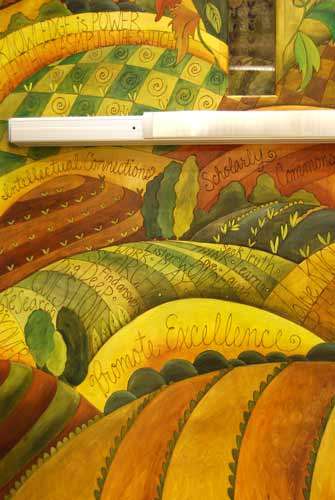
The main entry features a three-dimensional sculptural tree (representing the tree of knowledge) with hand-carved leaves on a stylized landscape background with 3-D carvings related to scientific knowledge icons. A "fall" color palette ties in with colors found in a large Sticks mural (celebrating the recent ISU 150th celebration) located close by, as well as representing "fall semester". The classroom sign hangs from a branch. The secondary entry features a "spring" color palette with a more two-dimensional carved tree to round out the academic year theme of "spring semester" and features colors found in the historic Grant Wood Murals located in the original 1925 Library entrance and staircase.
134 Parks Library Doors



The doorways for the Learning Connections Classroom (134 Parks Library) are graced by three-dimensional artwork from Sticks, a Des Moines-based art company.
The main entry features a three-dimensional sculptural tree (representing the tree of knowledge) with hand-carved leaves on a stylized landscape background with 3-D carvings related to scientific knowledge icons. A "fall" color palette ties in with colors found in a large Sticks mural (celebrating the recent ISU 150th celebration) located close by, as well as representing "fall semester". The classroom sign hangs from a branch. The secondary entry features a "spring" color palette with a more two-dimensional carved tree to round out the academic year theme of "spring semester" and features colors found in the historic Grant Wood Murals located in the original 1925 Library entrance and staircase.
134 Parks Library Doors



The doorways for the Learning Connections Classroom (134 Parks Library) are graced by three-dimensional artwork from Sticks, a Des Moines-based art company.
The main entry features a three-dimensional sculptural tree (representing the tree of knowledge) with hand-carved leaves on a stylized landscape background with 3-D carvings related to scientific knowledge icons. A "fall" color palette ties in with colors found in a large Sticks mural (celebrating the recent ISU 150th celebration) located close by, as well as representing "fall semester". The classroom sign hangs from a branch. The secondary entry features a "spring" color palette with a more two-dimensional carved tree to round out the academic year theme of "spring semester" and features colors found in the historic Grant Wood Murals located in the original 1925 Library entrance and staircase.